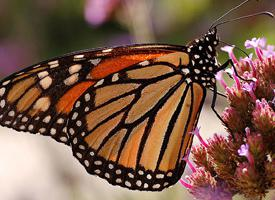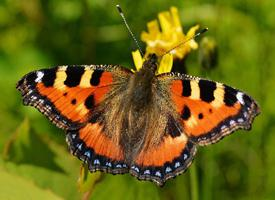
Description de l'animal
The Mourning Cloak, scientifically known as Nymphalis antiopa, is a remarkable and visually striking species of butterfly that belongs to the Nymphalidae family. This butterfly, with its distinct and captivating appearance, is widely recognized and admired across its extensive range, which spans across North America, Europe, and Asia, making it one of the most widespread of its genus.One of the most distinguishing features of the Mourning Cloak is its large, impressive wingspan, which can reach up to 4 inches (about 10 centimeters), making it one of the larger butterfly species in its regions of inhabitance. The wings are edged with a delicate fringe of short blue markings, closely bordered by an outer band of creamy white, which contrasts sharply against the darker background, giving the butterfly a regal and elegant appearance.
The main body of the Mourning Cloak's wings is a deep maroon or dark brown color, reminiscent of the velvety texture of mourning attire, from which it derives its common name. This rich, dark background is beautifully offset by a series of iridescent blue spots that line the border between the dark central area and the light outer rim, adding a touch of brightness and complexity to its overall appearance.
The Mourning Cloak is not only admired for its beauty but also for its unique behaviors and lifecycle. Unlike many butterflies that have a short lifespan, Mourning Cloaks are known for their longevity. They can live up to 12 months, which is notably longer than most of their counterparts. This extended lifespan is partly due to their ability to hibernate over the winter months, a rare trait among butterflies. They seek shelter in tree bark or other crevices to escape the cold, emerging in spring to mate and lay eggs.
The lifecycle of the Mourning Cloak begins with the female laying eggs in clusters around the branches of host plants, typically willow, elm, or poplar trees. The caterpillars that hatch are black with white spots and adorned with spiny, branched projections, giving them a somewhat menacing appearance. These caterpillars are gregarious, feeding in groups on the leaves of their host plants until they are ready to pupate. The chrysalis stage is relatively short, and the transformation into the adult butterfly is a fascinating process that captivates many nature enthusiasts.
Mourning Cloaks are solitary as adults and are often seen basking in the sun on cool days, with their wings spread wide to absorb heat. They are also known for their territorial behavior, especially the males, who will aggressively chase away intruders from their chosen sunning spots.
In terms of habitat, the Mourning Cloak is quite adaptable and can be found in a variety of environments including woodlands, parks, and gardens. Their preference for a range of deciduous trees as host plants for their larvae makes them a common sight in many temperate regions.
The Mourning Cloak butterfly, with its distinctive appearance, fascinating lifecycle, and adaptability, is a beloved species among naturalists and butterfly enthusiasts. Its ability to thrive in diverse environments and its presence across a significant portion of the globe make it a symbol of resilience and beauty in the natural world.
Animaux similaires
Nouvelles photos d'animaux
Top 10 des animaux
- Dolphin gull (Leucophaeus scoresbii)
- Japanese macaque (Macaca fuscata)
- Stone loach (Barbatula barbatula)
- Greek tortoise (Testudo graeca)
- Russian tortoise (Testudo horsfieldii)
- Galápagos tortoise (Geochelone nigra complex)
- Diana monkey (Cercopithecus diana)
- Moustached guenon (Cercopithecus cephus)
- Common flying dragon (Draco volans)
- Galápagos penguin (Spheniscus mendiculus)


